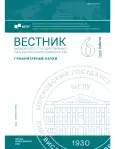Hate Speech in Network Space of the North Caucasus Multiethnic Regions: Functional and Pragmatic Analysis of Conflictogens
- Authors: Bredikhin S.N.1, Avdeev E.A.1, Shishkin B.A.1
-
Affiliations:
- North Caucasus Federal University
- Issue: No 6(887) (2024)
- Pages: 9-17
- Section: Linguistics
- URL: https://journal-vniispk.ru/2542-2197/article/view/303192
- ID: 303192
Cite item
Full Text
Abstract
The article provides a functional and pragmatic analysis of conflictogens as a key component of the hate speech. The empirical basis of the study is the online postings from the VKontakte social network and the Telegram messenger in the network space of the multiethnic regions of the North Caucasus. The key elements of conflictogenesis are pejoratives, critical remarks, accusations, insults, curses, censures and sarcasm, the soft and medium of hate speech dominates. Stereotypical zoonymic ethnopholisms are frequent in the comments.
About the authors
Sergey Nikolaevich Bredikhin
North Caucasus Federal University
Author for correspondence.
Email: bredichinsergey@yandex.ru
Doctor of Philology (Dr. habil.), Professor, Professor of the Department of Theory and Practice of Translation
Russian FederationEvgeniy Aleksandrovich Avdeev
North Caucasus Federal University
Email: ewg.avdeev@yandex.ru
PhD, Associate Professor of the Department of Philosophy and Ethnology
Russian FederationBoris Andreevich Shishkin
North Caucasus Federal University
Email: boris-shishkin.work@yandex.ru
Postgraduate student of the Department of Theory and Practice of Translation
Russian FederationReferences
- Brockmeyer, J., Harre, R. (2000). Narrativ: problemy i obeshhanija odnoj al’ternativnoj paradigm = Narrative: the problems and promises of one alternative paradigm. Voprosy filosofii, 3, 29–42. (In Russ.)
- Dijk, van T. (1997). Discourse as structure and process. London: Sage.
- Kinney, T. A. (2008). Hate Speech and Ethnophaulisms. The International Encyclopedia of Communication. Blackwell.
- Mullen, B., Rozell, D., Johnson, C. (2001). Ethnophaulisms for ethnic immigrant groups: the contributions of group size and familiarity. European Journal of Social Psychology, 31(3), 231–246.
- Mullen, B., Leader, T. I., Rice, D. R. (2009). Complexity and valence in ethnophaulisms and exclusion of ethnic out groups: What puts the “hate” into hate speech? Journal of Personality and Social Psychology, 96(1), 170–182.
- Benesch, S. (2012). Words as Weapons. World Policy Journal, 29(1), 7–12.
- Boromisza-Habashi, D. (2013). Speaking Hatefully: Culture, Communication, and Political Action in Hungary. Pennsylvania.
- Mazid, B.-E. M. (2012). HateSpeak in Contemporary Arabic Discourse. Cambridge Scholars Publishing.
- Waldron, J. (2012). The Harm in Hate Speech. Harvard University Press.
- Aguilera-Carnerero, C., Azeez, A. H. (2016). Islamonausea, not Islamophobia‘: the Many Faces of Cyber Hate Speech. Journal of Arab & Muslim media research, 9(1), 21–40.
- Ramdev, R., Nambiar, S. D., Bhattacharya, D. (2015). Sentiment, Politics, Censorship: The State of Hurt. SAGE.
- Gladilin, A. V. (2013). Hate speech in the traditional and new media. Bulletin of Chelyabinsk State University, 21(312), 144–153. (In Russ.)
- Tikhonova, E. V. (2015). Stereotipizacija i diskriminacija jetnokul’turnyh grupp: “otmyvanie informacii” i “jazyk vrazhdy” novyh media = Stereotyping and discrimination of ethnocultural groups: “information laundering” and “hate speech” of new media. Mirovoe kul’turno-yazykovoe i politicheskoe prostranstvo: innovacii v kommunikacii (pp. 485–503). Moscow: RUDN university. (In Russ.)
- Komarova, V. V., Osmak, N. A. (2020). Ethnofolism as an element of hate speech. Vestnik of Moscow State Linguistic University. Humanities, 5(834), 117–127. (In Russ.)
- Vasilenko, E. N. (2021). “Jazyk vrazhdy” kak forma projavlenija konfliktov, osnovannyh na stereotipah = “Hate speech” as a form of manifestation of conflicts based on stereotypes. Proceedings of BSTU. Series 4: Print and media technologies, 2(249), 90–97. (In Russ.)
- Panteleeva, T. Yu. (2016). “Jazyk vrazhdy” v paradigme jurislingvistiki: kognitivnosemanticheskij i pravovoj aspekty
- = “Hate speech” in the paradigm of legal linguistics: cognitive-semantic and legal aspects. News of the Southern Federal University. Philological sciences, 3, 96–103. (In Russ.)
- Lopatkina, S. V. (2021). Semantiko-strukturno-funkcional’nyj analiz jazyka vrazhdy v sovremennyh massmedia = Semantic-structural-functional analysis of hate speech in modern mass media. Bulletin of Omsk State Pedagogical University. Humanities studies, 4(33), 76–81. (In Russ.)
- Fomicheva, Ya. A., Shustova, S. V. (2023). Jazyk vrazhdy kak kommunikativnaja kategorija = Hate speech as a communicative category. Theoretical and applied linguistics, 9(4), 147–156. (In Russ.)
- Verkhovsky, A. M. (2002). Problema jetnicheskoj i religioznoj neterpimosti v rossijskih SMI = The problem of ethnic and religious intolerance in Russian media. Moscow: Panorama. (In Russ.)
- An-Navavi M. d. d. A. Z. b. Sh. (2008). Sady pravednyh = Gardens of the Righteous. Мoscow: Ummah. (In Russ.)
Supplementary files










